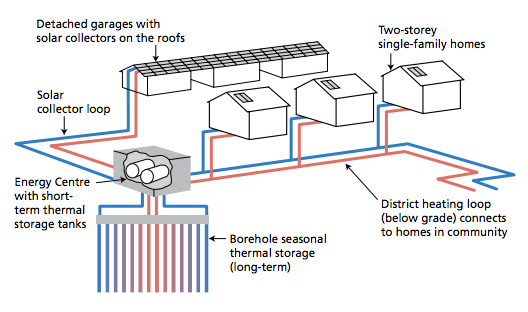 The Phase Change Matters e-mail newsletter is a weekly summary of the latest news and research on phase change materials and thermal energy storage. To subscribe, visit www.puretemp.com/subscribe. For more frequent updates, follow @puretemp on Twitter or visit the Phase Change Matters blog, www.puretemp.com/pcmatters.
The Phase Change Matters e-mail newsletter is a weekly summary of the latest news and research on phase change materials and thermal energy storage. To subscribe, visit www.puretemp.com/subscribe. For more frequent updates, follow @puretemp on Twitter or visit the Phase Change Matters blog, www.puretemp.com/pcmatters.
TEXTILES
Outlast’s new acrylic fiber uses unencapsulated phase change material
 Outlast Technologies and Thai Acrylic Fibre have developed a new acrylic fiber using unencapsulated phase change material.
Outlast Technologies and Thai Acrylic Fibre have developed a new acrylic fiber using unencapsulated phase change material.
Outlast says the new fiber performs four times better than the existing version in regulating temperature in apparel and blankets.
“We are using now a non-encapsulated pPCM system and we no longer work with encapsulated mPCMs here,” explained Martin Bentz, president of the Golden, Colo., company. “This change allowed us to improve the performance of the new Outlast acrylic fibers enormously. With that, the spinning and dyeing properties are enhanced.”
THERMAL ENERGY STORAGE

Drake Landing a model for combining solar, thermal storage in cold climate
CleanTechnica‘s Glenn Meyers offers a fresh look at Drake Landing Solar Community near Calgary, Alberta. The subdivision’s district heating system, which combines garage-mounted solar panels with thermal storage, supplies more than 90 percent of the space heating needs of 52 single-family houses. An array of 144 boreholes 37 meters deep serves as an in-ground heat sink for seasonal storage.
“U.S. developers with renewable energy goals should look closely at the DLSC model,” Meyers writes. “When calculating the energy savings, the large infrastructure costs can be offset over time. Potential homeowners may need convincing about future economic benefits that might be gained from being more independent from traditional utilities.”
RESEARCH
Leading interdisciplinary team helped PCM researcher see big picture
 In an interview on the European Cooperation in Science and Technology website, an assistant professor of engineering at Dublin’s Trinity College talks about how COST has helped her see the big picture in her research.
In an interview on the European Cooperation in Science and Technology website, an assistant professor of engineering at Dublin’s Trinity College talks about how COST has helped her see the big picture in her research.
Dr. Sarah McCormack chaired COST Action TU0802, developing an interdisciplinary community focused on renewable energy systems and phase change material.
“The main aim was to develop new materials for renewable energy storage applications in terms of heating and cooling, particularly renewable applications,” she said. “This did not necessarily mean coming up with new modeling techniques, but more accurate ones, by finding ways to incorporate phase change materials or thermal energy storage processes into software readily available. … The COST Action gave me a chance to meet other experts, look at the small-scale buildings aspects, and helped me understand how we can integrate these renewable energy systems.”
REGULATORY
Phase change material cool for schools, says BASF’s Tony Heslop
Tony Heslop, regional market development manager at BASF, weighed in this month on Britain’s $3 billion school repair and improvement program.
“Under the initiative,” he writes in the May issue of the Construction Index magazine, “draught-free ventilation is now mandatory and there is an expectation that passive cooling using thermal mass will be included in a school design.” Adding thermal mass in the form of plasterboard and ceiling tiles infused with phase change material can help designers comply with the new standards.
PATENT APPLICATION
Phase change material pack for air conditioning system
U.S. patent application 20150121944 (assignee: VKR Holding A/S, Denmark): “A phase change material (PCM) pack for an air conditioning system comprises phase change material sealed between a first thermally conductive layer forming a first outer surface of the PCM pack and a second thermally conductive layer forming a second outer surface of the PCM pack. At least the first or second outer surface of the PCM pack takes the form of a substantially planar surface having defined therein a plurality of depressions deviating from the planar surface towards the interior of the PCM pack in a direction perpendicular to the planar surface. The depressions improve heat transfer between the pack and an airflow passing over the surface of the PCM pack.”
RESEARCH ROUNDUP
For our full list of recent academic research, see puretemp.com/academic. Here are highlights from the past week:
From Renewable and Sustainable Energy Reviews:• Phase change materials for solar thermal energy storage in residential buildings in cold climate
From Journal of Applied Polymer Science:
• Poly(methyl methacrylate) copolymer nanocapsules containing phase-change material (n-dodecanol) prepared via miniemulsion polymerization
From International Conference on Information Sciences, Machinery, Materials and Energy:
• Influences of the PCM Microcapsules on Thermal Properties of the Garment [pdf]
From Energy Sources:
• Experimental Investigation of a Cascaded Latent Heat Storage System for Diesel Engine Waste Heat Recovery
From Journal of Food Engineering:
• Development of Polystyrene-based Films with Temperature Buffering Capacity for Smart Food Packaging
From Applied Thermal Engineering:
• Melting of phase change material assisted by expanded metal mesh
• Lattice Boltzmann simulation of convection melting in complex heat storage systems filled with phase change materials
From International Journal of Refrigeration:
• Improving Performance of Household Refrigerators by Incorporating Phase Change Materials
From Energy and Buildings:
• Preparation and thermal properties of form-stable phase change materials composed of palmitic acid/polypyrrole/graphene nanoplatelets
NETWORKING
Connect with PCM experts and industry leaders on LinkedIn
More than 180 of your colleagues have joined a new LinkedIn group devoted to the discussion of phase change material and thermal energy storage. The Phase Change Matters group is an interactive complement to the blog and newsletter of the same name.
You are invited to join the group and connect with PCM and TES experts from around the world. New members who introduced themselves this week include Jamie Pocklington, the global lead in Croda Chemicals‘ bio-based PCM business, and Rangasamy Pitchai, founder and CEO of ChemPlast Consultants.
Rangasamy writes: “I am leading a market development project for (tradename: CALGRIP) PCMs commercialized by JSR Corp. in Japan. They are paraffin-based and transform from solid to a gel. I am interested in new applications for phase change materials.”
A question submitted by Jerret Fischer, a sustainability expert with U-Haul International, prompted a new discussion:
“U-Haul has a 98,000-square-foot building in Houston, Texas. The building is used for customer storage as well as truck and trailer rentals. It can be very expense to cool the building in summer. Is it a good candidate for solutions that use phase change material? Can you recommend a turn-key solution?”
Among the responses so far:
“Apart from low-temperature or ice storage aside refrigeration units in order to allow the compressors to work at cheap hours and to reduce the peak demand, I can see no turn-key solutions. What is the average outside temperature at night and during the day in summer?” – Luc Traonvouez, INSULA France
“That’s about a 250 ton load if the 400 sq.ft. / ton rule of thumb works for this application. Sizing depends upon rates and facility use. Without knowing that and assuming no night time load, 8 hours of ice making and 12 hours of cooling the system would need a nominal 160 ton chiller and about 816 ton hours of storage for a partial storage solution.” – Paul Valenta, CALMAC
YOUR TURN
Got a question about PCMs or TES? Ask our experts
Two Entropy Solutions advisors, Dr. Mohammed Farid of the University of Auckland and Lucas B. Hyman of Goss Engineering, are ready to answer your questions about phase change material and thermal energy storage. We’ll select the best questions sent to inquiries@entropysolutionsinc.com and post the answers here each Friday.
OUR TURN
We’re taking a break
The Phase Change Matters blog and newsletter are on vacation. The blog will be updated sporadically over the next two weeks. Look for the next issue of the newsletter on May 29. Past issues are available here: